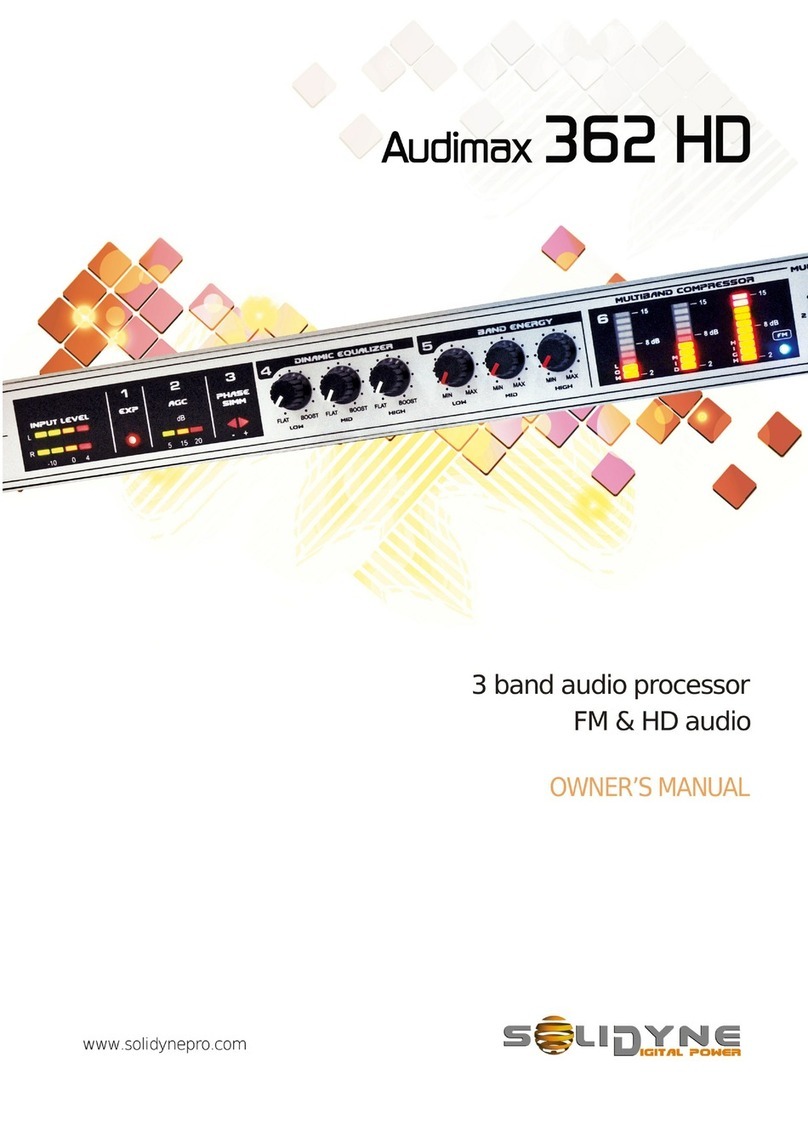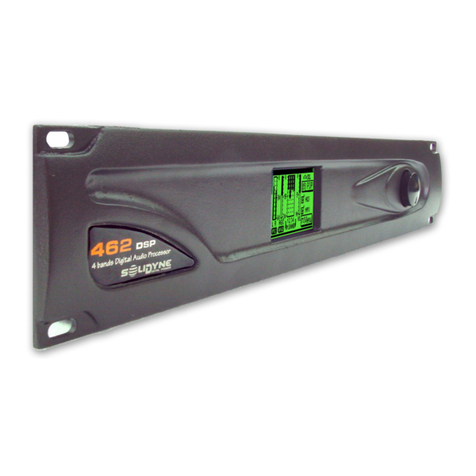Solidyne S-500 series User manual

Broadcasting Audio Console
S-500 series
- User’s manual-
Last revision: January 2006

page 2Consolas serie S-500 SOLIDYNE

INDEX
Introduction
Features
Inputs........................................................................................... 4
Outputs.........................................................................................4
Cue: Monitoring............................................................................4
VCA technology............................................................................4
C apter 1: Installation
1.1 Connecting t e Console...................................................5
1.1.1 Microphone mo ules ..........................................................3
1.1.2 Line mo ules ......................................................................3
1.2 Rear Panel
1.2.1 Power source.......................................................................6
1.2.2 On-Air signal (tally) .............................................................6
1.2.3 AUX-OUT Connector ..........................................................6
1.2.4 Balance line inputs ............................................................6
1.2.5 Lou speakers & hea phones outputs .................................7
1.2.6 Telephone line connection ..................................................7
1.2.7 External Hybri ...................................................................7
1.3 General connections diagram .........................................8
C apter 2: Operation
2.1 Introduction .......................................................................9
2.1.1 Checking the connections....................................................9
2.2 Módulos de Micrófono....................................................10
2.2.1 EQ.....................................................................................11
2.2.2 Compressor.......................................................................11
2.2.3 Phantom power source......................................................11
2.2.4 Gain a justments ..............................................................11
2.3 Line modules ...................................................................12
2.4 Recording ........................................................................13
2.5 Monitoring, ybrid & VU-meters ....................................13
2.5.1 Monitoring section..............................................................13
2.5.2 CUE ..................................................................................13
2.5.3 Talk-Back ..........................................................................14
2.5.4 VU-meters ........................................................................14
2.5.1 Operation of the Built-in Hybri .........................................14
C apter 3: Maintenance
3.1 Cleaning ..............................................................................15
3.2 Spare parts ..........................................................................15
C apter 4: Portable model S-500/6M.................................17
C apter 5: Tec nical specifications..................................19
SOLIDYNE Consolas serie S-500 page 3

FEATURES -
The Soli yne S-500 satisfies all the basic necessities of a ra io on-air stu y, obtaining excellent
cost/benefits relation. Unlike other consoles of low price, the S-500 has “ igital” au io quality. This unit
has been esigne specially for small an me ium ra ios that, in spite of counting on fewer resources,
wish to have equipment of first level in their stu ios. The S-500 offers to you the trustworthiness an
quality that characterize to the professional Soli yne equipment.
Brief description
Inputs
The S-500 console have 5 main fa ers of 4” length that manages: two microphone mo ules, with
balance inputs (Jacks ¼”) an 3 LINE mo ules with RCA connectors; two of them with balance inputs,
switche from the front panel of the console (Bal-1 an Bal-2). The fourth line is unbalance with an 1/8”
jack connector (Lin-4).
Mike modules have 4 bands EQ (+/- 15 B action); an an automatic audio compressor, which starts to
work when the signal surpasses the 0 VU. EQ an compressor can be bypasse in each mo ule.
An AIR input allows to connect an external AM/FM receiver to monitoring the on-air transmission.
Portable S-500/6M model: In this mo el, the line inputs are replace by microphone inputs, to obtain 6
microphone inputs. For etails refers to the Chapter IV.
Outputs
♦PROGRAM OUTPUT is use to sen the au io signal to the ‘air’. It’s a ¼” jacks balance output.
♦REC OUTPUT is use to recor ing a mo ule without sen it on-air. Is a balance out an is available
on the DB-15 connector.
Cue: Previous listening
Pressing a CUE button you can listen, even with the main fa er close , the signal present in this channel.
Pressing CUE again the operation is cancelle . The signal is listene through an built-in lou speaker,
locate on VU-panel. If button CUE is active in several mo ules, you will listen to the sum of the signals
present in each mo ule. The listening level a justs with the CUE LEVEL fa er, locate in the Master
mo ule.
VCA
Levels are controlle using VCA technology (Voltage Controlle Amplifier). With this technique, the au io
signal on’t circulates through the fa ers. The levels are controlle using electronic amplifiers of low noise
an great stability. The fa ers only manage DC that controls the amplifiers. The principal a vantages of
this technology are:
♦Eliminate noise an ‘crashes’ pro uce by irty or spent fa ers.
♦Eliminate the cleaning maintenance of the fa er.
♦Obtain a perfect stereo-tracking (< 0,1 B).
page 4Consolas serie S-500 SOLIDYNE

CHAPTER 1
-Installation
1.1 Connecting t e console
Although the S-500 is not a mo ular console, since it’s mounte on an unique printe boar , we will talk
about to the ifferent channels enominating them “mo ules”, by custom of use in other console mo els.
In spite of having an only circuit boar , the replacement of the main fa ers is simple, because these are
not wel e to the boar but that they are mounte to the chassis with screws.
All the I/O connectors are in the rear panel of the cabinet. Remember that a safe an free on faults
operation epen s of the wiring of the ifferent sources to the console, reason why we recommen you to
take the time necessary to make all connections with the greater care an always using material of high
quality. A goo solution is to acquire the complete cable set (kit Soli yne MNG-500).
1.1.1 Microp one modules
All microp one inputs are balance , with connectors Jack ¼” type. Remember that pins 1, 2 an 3 of the
XLR connector must be connecte to the Plug (TRS) to “sleeve”, “tip” an “ring” respectively, as showe in
1.3 – Connection general iagram.
P antom power source
The S-500 allows to activate a phantom power source which gives 9-12 VDC (between tip – ring). To use
mikes that operates with 48 V phantom, you must use an external power source. Please consult with your
Soli yne ealer to acquire external phantom’s; or contact us via e-mail.
¡Warning! Always use balance connections. Otherwise, hum an noise will can appear.
1.1.2 Line modules
There are 3 line modules. Each one has 2 stereo inputs, assignable from the front panel. Mo ules LIN-1
an LIN-2 can be switche between balance (DB-9) or unbalance (RCA) inputs. See Table-2 for
connection’s etails. LIN-3 mo ule can be switche to enter from an RCA input (LIN-3) or a minijack (1/8”)
calle LIN-4. This input is recommen e to connect a PC equippe with a non-professional soun car .
Each line mo ule has a gain control which affects both inputs. Gain controls compensate the input gain
for the ifferences of the sources, in or er to obtain a same output level for equal’s fa ers positions.
Following the actual engineer criteria, the input impe ance is bigger than 10 KOhms (Bri ging inputs). This
is a equate to all current equipment’s ( ecks, DAT, Au icom, Mini- isc, CD players, etc.) But if you nee
to a apt the impe ance to 600 Ohms, you must a a 680 Ohms resistor insi e the connector, in parallel
to the input.
SOLIDYNE Consolas serie S-500 page 5
This manual suits for next models
1
Table of contents
Other Solidyne Recording Equipment manuals




















